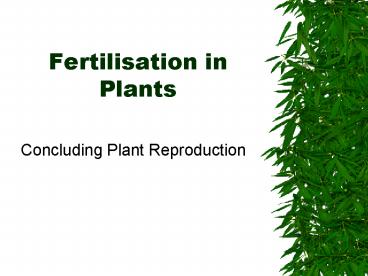Fertilisation in Plants PowerPoint PPT Presentation
Title: Fertilisation in Plants
1
Fertilisation in Plants
- Concluding Plant Reproduction
2
Plant fertilisation
- When pollen sticks to the stigma it absorbs water
and starts to germinate - A pollen tube will grow out of the grain and
through the style towards the ovary
3
Plant fertilisation
- The pollen tube nucleus remains close to the tip
of the tube. - Digestive enzymes are secreted from the tube.
- The tube is attracted by chemicals given out by
the ovary.
4
Plant fertilisation
- As the tube grows the generative nucleus divides
by mitosis to form two haploid male gametes.
5
Plant fertilisation
- The pollen tube enters the ovule through the
micropyle. - Once inside the ovule the tube nucleus
degenerates and the male gametes enter the embryo
sac
6
Plant fertilisation
- One of the male gametes fuses with the female
gamete forming a diploid zygote. - In plants a double fertilisation takes place as
the other male gamete fuses with the diploid
nucleus in the centre of the embryo sac forming a
triploid nucleus called the endosperm nucleus.
7
Outbreeding mechanisms
- How plants prevent self-fertilisation
8
Protandry
- Most flowers use this mechanisms, e.g. rose-bay
willowherb - The stamens ripen before the stigma is receptive
to pollen. - So pollen is gone by the time stigma is ready.
9
Protogyny
- More unusual than protandry e.g. the bluebell
- The stigma ripens before the anthers.
- By the time the anthers shed their pollen the
stigma is no longer receptive to it.
10
(No Transcript)
11
Dioecious Plants
- With dioecious plants each individual plant bears
either male or female flowers, but never both.
12
Dioecious Plants
- Paw-paw and holly are examples of dioecious
plants. - Clearly self-pollination is impossible!
PowerShow.com is a leading presentation sharing website. It has millions of presentations already uploaded and available with 1,000s more being uploaded by its users every day. Whatever your area of interest, here you’ll be able to find and view presentations you’ll love and possibly download. And, best of all, it is completely free and easy to use.
You might even have a presentation you’d like to share with others. If so, just upload it to PowerShow.com. We’ll convert it to an HTML5 slideshow that includes all the media types you’ve already added: audio, video, music, pictures, animations and transition effects. Then you can share it with your target audience as well as PowerShow.com’s millions of monthly visitors. And, again, it’s all free.
About the Developers
PowerShow.com is brought to you by CrystalGraphics, the award-winning developer and market-leading publisher of rich-media enhancement products for presentations. Our product offerings include millions of PowerPoint templates, diagrams, animated 3D characters and more.

